 Also known as brachioplasty, an arm lift reshapes the under portion of the upper arm, from the underarm region to the elbow
Also known as brachioplasty, an arm lift reshapes the under portion of the upper arm, from the underarm region to the elbow
Enhancing your appearance with an arm lift
Fluctuations in weight, growing older and even heredity can cause your upper arms to have a drooping, sagging appearance.
Exercise may strengthen and improve the underlying muscle tone of the upper arm, but it cannot address excess skin that has lost elasticity or underlying weakened tissues and localized fat deposits.
If the underside of your upper arms are sagging or appear loose and full due to excess skin and fat, an arm lift may be right for you.
An arm lift:
- Reduces excess skin and fat between the underarm and the elbow
- Reshapes your arm to result in smoother skin and contours
- Results in a more toned and proportionate appearance
A special note: In order to achieve your improved image, there will be a scar on the inside of your upper arm.
What is an arm lift?
An arm lift, or brachioplasty, is a surgical procedure that reshapes the under portion of the upper arm, from the underarm region to the elbow. The procedure is performed to:
- Reduce excess sagging skin that droops downward
- Tighten and smooth the underlying supportive tissue that defines the shape of the upper arm
- Reduce localized pockets of fat in the upper arm region
Is it right for me?
In general, candidates for an arm lift include:
- Adults with significant upper arm skin laxity
- Adults of any age whose weight is relatively stable and who are not significantly overweight
- Healthy individuals who do not have medical conditions that can impair healing or increase risk of surgery
- Non-smokers
- Individuals with a positive outlook and realistic expectations
The success and safety of your arm lift procedure depends very much on your complete candidness during your consultation. You’ll be asked a number of questions about your health, desires and lifestyle.
.jpg) Be prepared to discuss:
Be prepared to discuss:
- Why you want the surgery, your expectations and desired outcome
- Medical conditions, drug allergies and medical treatments
- Use of current medications, vitamins, herbal supplements, alcohol, tobacco and drugs
- Previous surgeries
Your surgeon may also:
- Evaluate your general health status and any pre-existing health conditions or risk factors
- Take photographs for your medical record
- Discuss your options and recommend a course of treatment
- Discuss likely outcomes of arm lift surgery and any risks or potential complications
 Prior to surgery, you may be asked to:
Prior to surgery, you may be asked to:
- Get lab testing or a medical evaluation
- Take certain medications or adjust your current medications
- Stop smoking well in advance of surgery
- Avoid taking aspirin, anti-inflammatory drugs and herbal supplements as they can increase bleeding
Special instructions you receive will cover:
- What to do on the day of surgery
- The use of anesthesia during your arm lift
- Post-operative care and follow-up
Your plastic surgeon will also discuss where your procedure will be performed. Arm lift surgery may be performed in an accredited office-based surgical center, outpatient or ambulatory surgical center, or a hospital.
You’ll need help
If your arm lift is performed on an outpatient basis, be sure to arrange for someone to drive you to and from surgery and to stay with you for at least the first night following surgery.
Step 1 – Anesthesia
Medications are administered for your comfort during the surgical procedures. The choices include intravenous sedation and general anesthesia. Your doctor will recommend the best choice for you.
Step 2 – The incision
Incision length and pattern depend on the amount and location of excess skin to be removed, as well as the best judgment of your plastic surgeon.
Incisions are generally placed on the inside of the arm or on the back of the arm, depending on the surgeon’s preference, and may extend from the underarm (axilla) to just above the elbow. If fat is to be reduced during your arm lift, it will be excised or treated with liposuction.
Inner Arm Incision
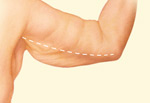
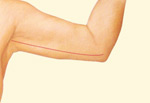
Depending on your specific conditions, incisions may be more limited. Then, underlying supportive tissue is tightened and reshaped with internal sutures. Finally, the skin is smoothed over the new contour of your arm.
Back of Arm Incision
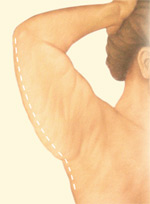
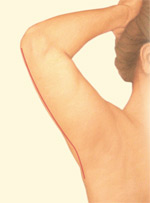
Minimal Incision
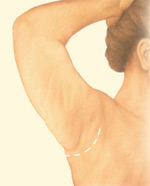
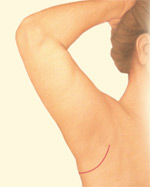
Step 3 – Closing the incisions
Your incisions will be closed with absorbable sutures, or stitches that will be removed within 1-2 weeks following your arm lift.
Step 4 – See the results
The smoother, tighter contours that result from brachioplasty are apparent almost immediately following your procedure, although initial results will be somewhat obscured by swelling and bruising. Your new, shapely and toned upper arm is dramatically improved both in appearance and feel.
The decision to have arm lift surgery is extremely personal and you’ll have to decide if the benefits will achieve your goals and if the risks and potential complications are acceptable.
You will be asked to sign consent forms to ensure that you fully understand the procedure you will undergo and any risks and potential complications.
The risks include:
- Unfavorable scarring
- Bleeding (hematoma)
- Infection
- Fluid accumulation
- Anesthesia risks
- Poor wound healing
- Skin loss
- Blood clots
- Numbness or other changes in skin sensation
- Skin discoloration and/or prolonged swelling
- Asymmetry
- Major wound separation
- Fatty tissue found deep in the skin might die (fat necrosis)
- Damage to deeper structures such as nerves, blood vessels, muscles, and lungs
- Pain, which may persist
- Deep vein thrombosis, cardiac and pulmonary complications
- Sutures may spontaneously surface through the skin, become visible or produce irritation that require removal
- Possibility of revisional surgery
These risks and others will be fully discussed prior to your consent. It is important that you address all your questions directly with your plastic surgeon.
It is natural to feel some anxiety, whether excitement for the anticipated outcomes or preoperative stress. Discuss these feelings with your plastic surgeon.
When you go home

If you experience shortness of breath, chest pains, or unusual heart beats, seek medical attention immediately. Should any of these complications occur, you may require hospitalization and additional treatment.
The practice of medicine and surgery is not an exact science. Although good results are expected, there is no guarantee. In some situations, it may not be possible to achieve optimal results with a single surgical procedure and another surgery may be necessary.
Be careful
Following your physician’s instructions is key to the success of your surgery. It is important that the surgical incisions are not subjected to excessive force, swelling, abrasion, or motion during the time of healing. Your doctor will give you specific instructions on how to care for yourself.
Be sure to ask questions:
It’s very important to ask your plastic surgeon questions about your arm lift procedure. It’s natural to feel some anxiety, whether it’s excitement for your anticipated new look or a bit of preoperative stress. Don’t be shy about discussing these feelings with your plastic surgeon.
 Following your surgery, dressings or bandages may be applied to your incisions, and your arms may be wrapped in an elastic bandage or a compression garment to minimize swelling. A small, thin tube may be temporarily placed under the skin to drain any excess blood or fluid that may collect.
Following your surgery, dressings or bandages may be applied to your incisions, and your arms may be wrapped in an elastic bandage or a compression garment to minimize swelling. A small, thin tube may be temporarily placed under the skin to drain any excess blood or fluid that may collect.
You will be given specific instructions that may include: How to care for the surgical site and drains, medications to apply or take orally to aid healing and reduce the potential for infection, specific concerns to look for at the surgical site or in your general health, and when to follow up with your plastic surgeon.
Be sure to ask your plastic surgeon specific questions about what you can expect during your individual recovery period.
- Where will I be taken after my surgery is complete?
- What medication will I be given or prescribed after surgery?
- Will I have dressings/bandages after surgery?
- When will they be removed?
- Are stitches removed? When?
- When can I resume normal activity and exercise?
- When do I return for follow-up care?
 The results of arm lift surgery will be long-lasting, provided that you maintain a stable weight and general fitness. As your body ages, it is natural to lose some firmness, but most of your improvement should be relatively permanent.
The results of arm lift surgery will be long-lasting, provided that you maintain a stable weight and general fitness. As your body ages, it is natural to lose some firmness, but most of your improvement should be relatively permanent.
Cost is always a consideration in elective surgery. Surgeon’s cost for an arm lift may vary based on his or her experience, the type of procedure used, as well as geographic office location. Many plastic surgeons offer patient financing plans, so be sure to ask.
Cost may include:
- Surgeon’s fee

- Hospital or surgical facility costs
- Anesthesia fees
- Prescriptions for medication
- Post-surgery garments
- Medical tests
Your satisfaction involves more than a fee
When choosing a plastic surgeon for an arm lift, remember that the surgeon’s experience and your comfort with him or her are just as important as the final cost of the surgery.
Most health insurance does not cover cosmetic surgery or its complications.
- Arm lift: A surgical procedure, also known as brachioplasty, to correct sagging of the upper arms.
- Axilla: The underarm area.
- Brachioplasty: A surgical procedure, also known as arm lift, to correct sagging of upper arms.
- General anesthesia: Drugs and/or gases used during an operation to relieve pain and alter consciousness.
- Hematoma: Blood pooling beneath the skin.
- Intravenous sedation: Sedatives administered by injection into a vein to help you relax.
- Liposuction: Also called lipoplasty or suction lipectomy, this procedure vacuums out fat from beneath the skin’s surface to reduce fullness.
- Local anesthesia: A drug injected directly to the site of an incision during an operation to relieve pain.
- Skin laxity: Degree of loose skin.
- Sutures: Stitches used by surgeons to hold skin and tissue together.
Use this checklist as a guide during your consultation
- Are you certified by the American Board of Plastic Surgery?
- Were you specifically trained in the field of plastic surgery?
- How many years of plastic surgery training have you had?
- Do you have hospital privileges to perform this procedure? If so, at which hospitals?
- Is the office-based surgical facility accredited by a nationally- or state-recognized accrediting agency, or is it state-licensed or Medicare-certified?
- Am I a good candidate for this procedure?
- What will be expected of me to get the best results?
- Where and how will you perform my procedure?
- What surgical technique is recommended for me?
- How long of a recovery period can I expect, and what kind of help will I need during my recovery?
- What are the risks and complications associated with my procedure?
- How are complications handled?
- How can I expect my arms to look over time?
- What are my options if I am dissatisfied with the cosmetic outcome of my arm lift?
- Do you have before-and-after photos I can look at for this procedure and what results are reasonable for me?
Plastic surgery involves many choices. The first and most important is selecting a surgeon you can trust.
Choosing an ASPS Member Surgeon ensures that you have selected a physician who:
- Has completed at least five years of surgical training with a minimum of two years in plastic surgery.
- Is trained and experienced in all plastic surgery procedures, including breast, body, face and reconstruction.
- Operates only in accredited medical facilities
- Adheres to a strict code of ethics.
- Fulfills continuing medical education requirements, including standards and innovations in patient safety.
- Is board certified by The American Board of Plastic Surgery or in Canada by the Royal College of Physicians and Surgeons of Canada®.
ASPS Member Surgeons are your partners in cosmetic and reconstructive plastic surgery.
Look for the ASPS Member Surgeon logo.

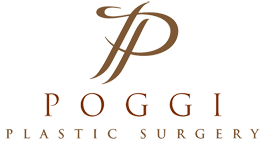 3510 N. Ridge Rd, Suite 100
3510 N. Ridge Rd, Suite 100